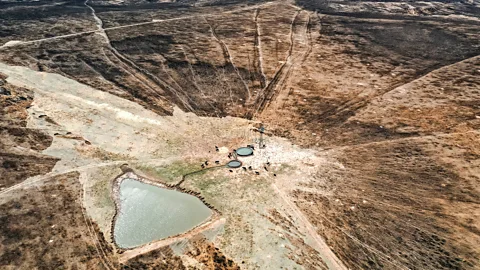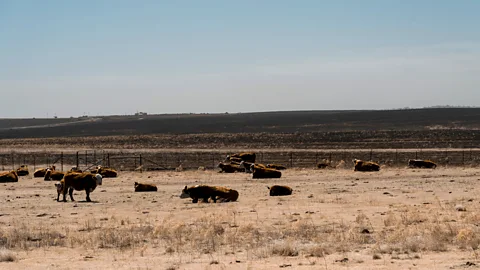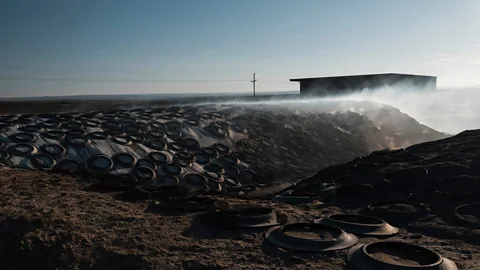The worst wildfire in Texas' history has a complex link with climate change
 Getty Images
Getty ImagesThe worst wildfire in Texas' history is leaving wide scars on the landscape. Why is the blaze so extreme?
Temperatures dropped and snow began to fall on the Texas panhandle, dusting the scorched grasslands, thousands of dead cattle, and hundreds of burnt-out buildings with a fine layer of white powder. It was a welcome relief – and an apocalyptic image – for the state, which has been battling its worst wildfire in history.
The Smokehouse Creek fire, which started on 26 February in Hutchinson County, has so far burned more than 1.2 million acres (486,000 hectares), and killed two people and thousands of cattle. On 27 February, Texas Governor Greg Abbott issued a disaster declaration for 60 counties in response to the wildfire.
Wildfire risk is expected to increase across Texas as climate change brings drier, hotter conditions, according to a 2021 report by Texas state climatologist John Nielsen-Gammon. The wildfire season will likely last longer in places where there is little rain, such as eastern Texas and areas commonly affected by wildfires may expand eastward, as fuels become drier faster, thanks to a warmer climate.
But the Smokehouse Creek fire did not spread so rapidly and burn so intensely because of any prolonged drought – instead, the flames were exacerbated by a wet winter. The reasons behind this kind of extreme fire behaviour are not quite as clear cut as one might first think.
Why drought did not fuel the Texas blaze
Extreme wildfires have become more common across the US in recent years, primarily thanks to drought and warming temperatures. But the area where the Smokehouse Creek fire is burning – just north of Amarillo – is not currently in extreme drought like other more southerly areas of Texas.
"Drought has not dominated Texas's climate nearly as strongly as it has in the region to the west," says Park Williams, a University College of Los Angeles geography professor. In 2020, Williams published a study which showed the American south-west is currently experiencing a megadrought – the worst dry period the region has seen since 800AD. But only a "sliver" of Texas was included in the study, Williams says.
Sign up to Future Earth
Sign up to the Future Earth newsletter to get essential climate news and hopeful developments in your inbox every Tuesday from Carl Nasman. This email is currently available to non-UK readers. In the UK? Sign up for newsletters here.
The primary reason the Smokehouse Creek fire spread so quickly was due to a relatively wet winter, combined with warm temperatures and high wind speeds, Williams explains.
There are other ingredients for wildfires aside from drought; four "switches" are required: fuel abundance, fuel dryness, source of ignition and suitable conditions for fire spread. In Texas, these switches are often flipped in the first part of the year when it comes to extreme fire: of the 30 largest wildfires in Texas history, 90% occurred between January and May.
There's still relatively little research on how wet winters impact wildfire intensity. "Climate change may have affected the amount of vegetative growth that provided fuel for the fire," says Nielsen-Gammon, "but there hasn't been much work on the subject."
 Getty Images
Getty ImagesWhy have the fires in Texas been so bad?
Texas generally receives more rainfall in the summer, the warmest part of the year, and it is dry but cold in winter and spring. "In other words, key factors for fires do not line up perfectly: it's cold when it's dry but wet when it's warm," says Flavio Lehner, assistant professor of Earth and Atmospheric Sciences at Cornell University in New York says. Except, for this year.
The Smokehouse Creek fire followed an unusual weather period.
In mid-February, the week prior to the fire, cities in the panhandle broke records for high temperatures, hitting 83-85F (28-29C). Then strong, cold winds blew in – hitting up to 70mph gusts, fanning the flames and pushing the wildfires to the east. Another wind blew in southward, shifting the fires to the south.
"Given the weather pattern and strong winds, climate change would be expected to cause higher temperatures and greater evaporation rates, leading to drier fuels that are easier to ignite and burn," says Nielsen-Gammon.
Why long-term droughts may lead to more wildfires
Drought does increase the probability of large-scale wildfires by drying out the soil. It also increases fire intensity because more fuel is available to burn, and the drying of organic material in the soil can make suppressing fires much harder.
"Megadroughts can set the perfect scene for large wildfires," says Danielle Touma, research assistant professor at University of Texas' institute for geophysics. "It can also make it more difficult to suppress wildfires due to the limited amount of water in the region."
 Getty Images
Getty ImagesBut there's a flip side, Touma adds. There can be less vegetation growth due to drought, which would prevent regrowth of vegetation in areas have already been burned. Essentially, if there's not enough water for vegetation to grow, there's no fuels for fire to burn.
What is certain however it that higher temperatures and drought conditions in Texas are likely to increase the severity, frequency, and extent of wildfires in the future. A 2020 study warned that water stakeholders should prepare for future droughts that will be unlike anything the region has experienced, as climate projections portray an "unprecedented" drought risk.
You might also like:
The current blaze shows how severe a fire can be even without these added pressures. Lehner described the growth of the Smokehouse Creek fire as "explosive".
"It's not surprising to see wildfires in this area, although the rate at which this one grew and also the area it has burned so far are certainly exceptional," Lehner says. "Like a lot of grass and shrub-land fires, the wind is the key factor, driving the fire across the landscapes at speeds effectively outpacing fire suppression efforts."
Texas' climate is expected to become more fire prone, Lehner says. "It's more likely than not that conditions favourable for wildfire will become more common in Texas in the future." The entire state is facing longer and more intense drought conditions, creating "fire weather".
The uncertainties of a changing climate
But, he adds, climate change is making it harder to foresee how quickly and to what extent Texas will become more vulnerable to wildfire. "Interestingly, with climate change we are observing an eastward shift of the dividing line between these two climate zones, which means Texas' climate, especially in the panhandle area, is expected to become more fire prone."
But, as Williams notes, precipitation plays a key role – which can be hard to anticipate.
"How quickly and how strongly this will happen is difficult to say, as it depends a lot on how rainfall patterns will change." Rainfall is much more challenging to predict than warming temperatures, says Williams, due to the complexity of the processes that generate precipitation. Climate change will also make rainfall even harder to predict.
In this particular region of Texas, the panhandle, where there are extensive grasslands, it is less clear how continued climate change will affect wildfire overall, Williams continues. "In order for warming to have a reliable influence on fire, abundant fuels are needed, and the grassland fuel availability in this region is strongly affected by year-to-year swings in precipitation."
 Getty Images
Getty ImagesWhat does this mean for Texans?
The state is one of the country's leading exporters of agriculture commodities – 86% of Texas land is in some form of agricultural production and the industry employs one out of every seven working Texans.
"Cattle and crop losses are significant and infrastructure damage is catastrophic," said Sid Miller, commissioner for the Department of Texas Agriculture. "I know of ranchers who have lost everything. Even those Texans fortunate enough to save their herd may not have anything to return to but ashes."
The industry was already facing pressure from the widespread drought that gripped the state last year, forcing cattle ranchers to manage smaller herds – which led to higher beef prices and contributed to a decrease in beef production nationally.
That the Smokehouse Creek Fire was not the result of prolonged drought is even more concerning for Texans, but follows the pattern of weather in the state becoming more frequent, more extreme. Data projections predict a significant increase in the land burned by wildfires – for example, by 2050 Colorado is expected to see a 600% increase in areas burned by fire. As always, the key in coping with these events is preparation. Managing the land – through prescribed burns and managing fuels, can decrease fire spread and intensity.
"When you have an unprecedented event like this, there's a chance that communities are not adequately prepared, as they simply have not experienced this before," says Lehrer.
--
If you liked this story, sign up for The Essential List newsletter – a handpicked selection of features, videos and can't-miss news delivered to your inbox every Friday.
